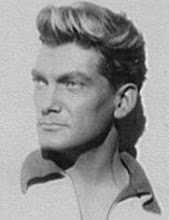



For over 50 years, Sydney Jay Mead has made a very successful career as a 'Visual Futurist'. His talents have taken him around the world, with significant stop-offs in Hollywood and Detroit where his personal take on technology of the future has informed major projects like Blade Runner, Aliens and Star Trek. For many years he worked in the Advanced Styling Center for Ford Motors in Dearborn, then Detroit, Michigan.He also created futuristic visions of steel applications in promotional publications for US Steel in the 1960s.
Mead's conceptions of the future are seductively rendered full colour pieces, often featuring unusually attired people engaged in everyday activities. Usually, the backdrop is a familiar, yet technologically advanced, environment. This whiff of the mundane adds a certain plausibility to Mr Mead's vision. A recurrent motif in these pictures are weird half-animal half-robot family pets, elaborate brocaded semi-military caped outfits and identity (and humanity) concealing hi-tech helmets. The overall effect can be slightly menacing, maybe this is part of Mead's vision of the future.















































